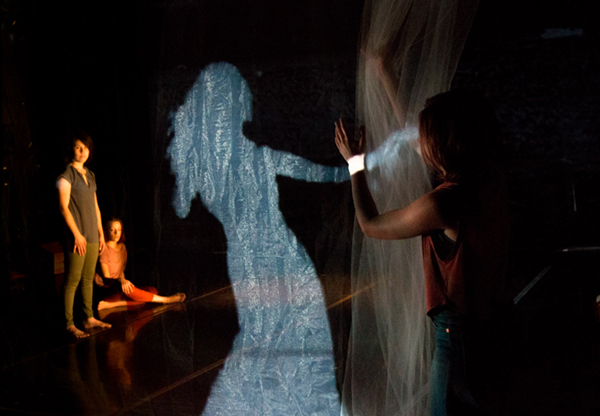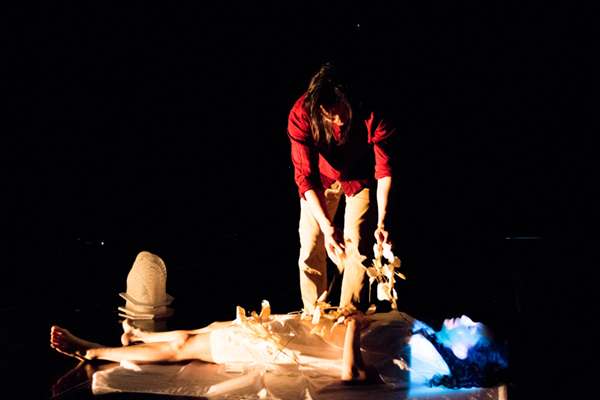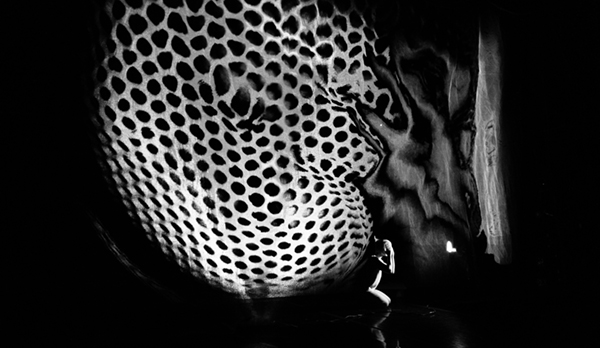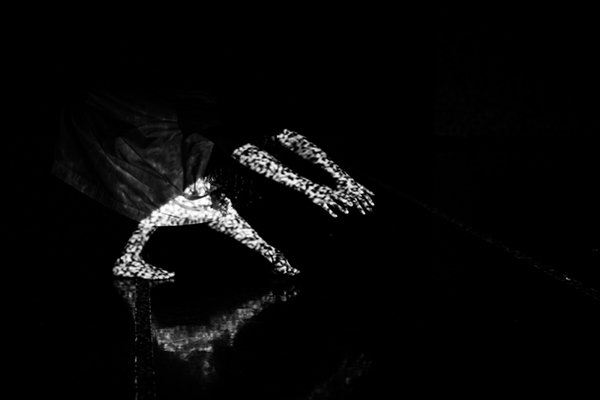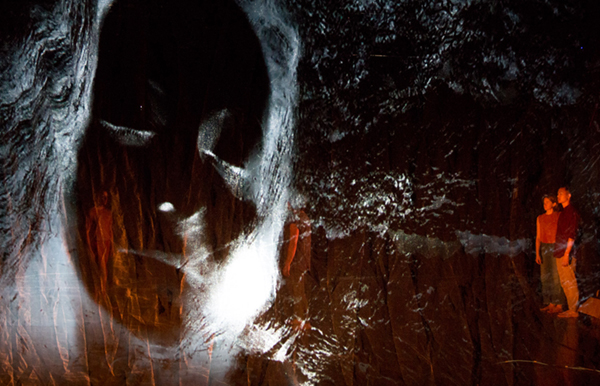Kinetech Arts Plays with Dance and Technology
An Interview with Daiane Lopes da Silva and Weidong Yang of Kinetech Arts
BY EMMALY WIEDERHOLT
Daiane Lopes da Silva and Weidong Yang founded Kinetech Arts in 2013 to create performances that combine dance and science with the newest interactive technology. Based in San Francisco, the couple also hosts the annual DanceHack, a dance + tech event. Here they talk about how dance, science and technology can inform each other, making rich collaborations and outcomes.
Photo by Weidong Yang
~~
Can you share a bit about your history and how you came to found Kinetech Arts?
Daiane: Weidong started playing with different technologies at home. He would show me stuff, and we’d goof around with it and have a good time. Sometimes we’d have friends over who would join in, and they always thought it was cool and interesting.
Weidong: I’m a physicist, and I like to play with mixing time and space. I see parallels between the complexities of science and dance. There’s a concept called the fractal that we’ve used a lot in our experiments. The fractal represents a compact system that’s very interesting to me. In 2013, I started a residency at KUNST-STOFF. I wasn’t interested in making a piece but instead having a lab for people to come and play with interactive technology and movement.
Daiane: He turned his residency into a playground for dancers. It was about a three months long residency and, once a week, it turned into a lab. After the residency ended, we just continued the Open Lab, which we’ve been doing once a week for six years. After a few months, we decided to also create performances with ideas that were initiated in the lab. At the Open Lab, sometimes we play with a technology, and sometimes with a concept, like how sound, light, movement and emotion come together. We test a lot of ideas in the lab. Sometimes it’s random and we only have a vague idea of something to play with. Sometimes people bring something to test or want to show projects they are working on, so there’s also space for others to experiment. The attendees are quite mixed – dancers, scientists, musicians, technologists, visual artists, opera singers, even dogs.
How would you describe your work to someone unfamiliar with it?
Daiane: I work with contemporary dance, and I am very interested in improvisation. I create improvisational scores for dancers to compose in real time as well as choose and edit material that they create in a collaborative environment. The work is usually emotionally charged. I’m interested in the ways people view and feel about the world and how they express it through movement. Audience members have reported they feel very touched after witnessing our performances. They also think it is innovative.
Photo by Weidong Yang
Weidong: The technology coupled with the dancers’ movements creates striking visuals. For example, in one application we developed called Time Bubble, the movement causes the visual to go back in time. Our past show, Mesh, was a reflection on the experience of people going through cancer treatment. In the performances, we had a translucent screen made of an almost invisible fabric that made the dancers look like they were floating on the air, almost ghostly. We used Time Bubble to project visuals generated by the dancers onto the screen.
What does your work process generally look like?
Daiane: In the beginning of Kinetech Arts, we started with the technology. We were hypnotized by the new tools. However, I soon realized that, as a choreographer, this didn’t work for me. Technology was dictating too much. We decided to flip it and start with the dance. Now I start by working with the dancers in the studio without technology. We always choose a theme to work with. In Mesh, it was: How do people go through difficult and challenging situations? How do they support each other? Our new performance is about the heartbeat. Then the technology comes after, but it’s always a conversation between dance and technology. Technology informs the way I move forward with the work. It transforms the material we create and changes the score. When the technology comes in, it might allow us to go in a different direction.
Weidong: A unique thing we’re doing is borrowing from open source software development in that instead of ideas being possessed by a single person, ideas can be shared. It’s one of the reasons why we host the Open Lab. We invite people to come in, learn from each other, and share. Through sharing what we’re working on in the Open Lab environment, we get fresh angles, and the work evolves.
Can you share a little about DanceHack and how it is organized?
Weidong: DanceHack is a two-day event where about 80 people get together, half engineers and half dancers. We have a pre-hack mixer to get to know each other and find out what technologies or art forms are being developed. People arrive Saturday morning and naturally form groups who will work together. We host workshops about things that can help bring dance and technology together, like Isadora software or motion sensing. We also host movement-based workshops. From there, the groups develop a quick prototype. There are usually between 15-20 groups. It’s quite a scene to see all the groups working intensively at once. Most of the time, the participants don’t already know each other. Everyone is so hungry and open to experiment. Late Saturday, we go around to all the groups and start to put together a showcase. On Sunday night, all the groups share what they developed. This past year, we used the mainstage and basement at CounterPulse.
Daiane: It’s so sincere, spontaneous and raw. There’s no time to polish; that’s an interesting part of this creative process. You just have to go with what came out, and that creates a seed.
Weidong: It’s also interesting to note the different approaches between the artists and engineers. Engineers are less comfortable with uncertain outcomes. If they have something they want to build, they are usually very clear what that is. Anything that comes out that is not in line with the desired outcome is considered a mistake. The art process is often the opposite; artists discover their material through just trying things and making mistakes. I’ve found that engineers are really challenged at the DanceHack. If something doesn’t go right, the engineer wants to fix it. But the dancer is like, “That’s amazing! I love the colors and patterns.” There are many moments like that. We really encourage participants, especially the engineers, to embrace mistakes and turn it into aspects of the art.
Photo by Robbie Sweeny
Daiane: It’s surprising how many people are interested in coming to the DanceHack. People have flown in from the East Coast, LA, NYC, Seattle, even Russia. It’s preregistered, and there’s a huge waiting list. There are usually 80 spots, plus 40 spots on the waiting list. We’ve been doing it for five years now, usually the first weekend of December. We’re very grateful to CounterPulse, who have been our partners for the past three years. They’ve been very supportive.
The tech industry has dominated the Bay Area for a couple decades now – how has being based in San Francisco affected Kinetech Arts?
Weidong: Being in San Francisco has made this exploration easier. I have friends who wanted to do something similar to Kinetech Arts in Seattle or LA, but it’s not that easy. There’s more diversity and open-mindedness here. To be frank though, there’s not a lot of financial support, just a lot of grass roots interest.
In what ways do you see tech changing the way choreography is approached?
Weidong: It’s more about the media; movies and TV are changing how dance is presented. But technology itself is just a tool.
Daiane: Technology has been used in dance for such a long time. It’s not particularly new. What makes me really puzzled is that many dancers resist technology. There’s huge resistance from most of my friends and colleagues; they’re not interested. They think that technology takes us away from our bodies. For me, I ask: What is technology? The main technology at Kinetech Arts is the body. The body is a form of technology. And we use many forms of technology at Kinetech Arts. Sometimes we even use old technologies like flashlights! When we talk about technology nowadays, we’re usually referring to innovative new stuff. In the beginning, I was very resistant too. Then I flipped the way I work. Technology has taught me so much about my movement. In motion capture, for example, I can see how I’m shifting my weight or using my joints. I really don’t think technology is bad; it’s how you use it. We can learn so much about movement patterns. When we work with technology, it opens the space and makes it more interactive. It’s not only about what we’re doing with our bodies. When we train as dancers, we’re so concerned and self-involved in articulation. With interactive technology, we’re not only aware of the body but how it is connected to the environment. It opens up so much possibility.
Weidong: We usually bring in technology that isn’t deterministic. This means it cannot be predicted; there’s always an uncertainty. It keeps the dancers on the tips of their toes because they don’t know exactly what will happen. This is partially driven by the idea of compact theory, that a system has order but also randomness. This type of system has the highest level of complexity and shows life-like behavior. It is always behind whatever technology we use. This is a challenge to the dancers because the environment is never static. It’s always shifting in that you can see the pattern but can’t predict it.
Photo by Robbie Sweeny
Conversely, can choreography inform the ways technologies are developed?
Daiane: We also have this event called Y-Exchange. It used to be called the Featured Artist Presentation. It’s through a partnership with ODC and the Djerassi Resident Artists Program. We invite one artist and one scientist to talk about their work and then have a Q&A. For our talk last November, we had Serena Sanulli, a scientist and dancer, who talked about DNA.
Weidong: If you expanded a strand of DNA, it would be five meters long. In the cell, it’s less than a micro-meter in size. It’s been a mystery how this is possible: How does DNA fold into so small a size but still be able to express itself? As a dancer, Serena had an intuitive sense of movement. Through practicing contact improvisation, she knew that movement response can create possibilities. This was one of the guiding insights in her discovery: In order for DNA to fold into such a small size, it literally has to be constantly dancing. The moment the dance stops, DNA stops. That was a pretty big discovery made in the past year. There’s been lots of research and study along that direction since. That’s one example of how dance can influence discovery in a system.
Daiane: Wei is also a dancer and martial artist in addition to being a scientist, and he says his mind is clearer and more creative after dancing.
What are you currently working on/focused on?
Daiane: We’re creating a new project about the heart. We are current resident artists at ODC, and we’re going to be performing an excerpt at CounterPulse on March 16th together with cellist Joshua McClain as part of the To Be Free Festival. On May 16th and 17th, we’re going to perform the full version at ODC theater.
Weidong: In this piece, we are using ECGs and electronic stethoscopes. We built an ECG device with an electrode that goes on the body and measures the cardio electrical signals. We’re also using this thing that measures the reflectiveness of the skin. It’s a small device where you put your finger on it, and it measures the density of blood flow. Those measurements will come from dancers and audience members alike, and then that information will be transformed into sound, light, video and musical/dance improvisation.
~~
To learn more, visit kinetecharts.org.
Photo by Weidong Yang
Daiane Lopes da Silva is a dancer, choreographer, teacher and artistic director of Kinetech Arts. Her work has been performed in Brazil, France, Belgium, Greece and the U.S. She was a resident artist at SAFEhouse arts, CounterPulse and Headlands Center for the Arts. Daiane studied at The Municipal Ballet of São Paulo, Brazil and at P.A.R.T.S (Performing Arts Research and Training Studios) in Brussels. She graduated with a B.A. in Psychology from SFSU. She is on faculty at Alonzo King Lines Ballet Dance Center and Western Ballet.
Weidong Yang, co-founder of Kinetech Arts, is a scientist, dancer, photographer, and martial artist. Born in China and educated in the US, he works to synthesize his background in technology and art into new forms of expression. In addition to his work with Kinetech Arts, Weidong is CEO of Kineviz, a data visualization company he founded in 2014.

